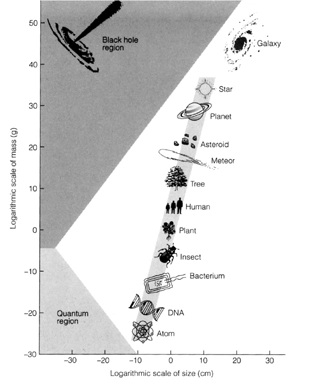This is vastly bigger than any information storage capacity that has so far been produced. Similarly, there is an ultimate limit on the rate of processing of information that is imposed by the constants of Nature.
It is also very remarkable that we are able to use the Planck and Stoney units to classify the whole range of structures that we see in the Universe, from the world of elementary particles up to the largest astronomical structures. These are shown in Figure 3.3. The structures shown on this picture are the stable entities that exist in the Universe. They exist because they are stable balancing acts between competing forces of attraction and repulsion. For example, in the case of a planet, like Earth, an equilibrium arises between the attractive crushing force of gravity and the atomic repulsion that arises when atoms are squeezed too close together. All these equilibria can be roughly expressed in terms of two pure numbers created from the constants e, h, c, G and mpr

There are three interesting things to say about this picture. First we notice that most things lie along a straight line running diagonally upwards from left to right. This line corresponds to the track of constant density that is equal to what we call ‘atomic density’. Everything that is made of atoms has a density quite close to the density of a single atom given by the mass of an atom divided by its volume.20 Second, there are some large empty areas in this picture. If we add to the picture the line defining where black holes and their interior regions sit then we take out the whole of the top left triangle of the picture. Nothing from this region could be seen. Its gravity would be too strong to allow light to escape. Similarly, nothing in the bottom left corner triangle would be detectable. This ‘quantum region’ contains objects which are so small that the act of observing them would perturb them into another part of the picture.

Figure 3.3The pattern with which the observed structures in the Universe fill the size-mass plane is dictated by three factors. The line of constant atomic density, the line that marks the black hole region within which things would be inside black holes (and hence invisible), and the line marking the uncertainty principle of quantum mechanics which separates off the quantum region in which the usual concepts of size and mass cannot be simultaneously maintained. We see that most of the familiar structures in the universe lie on or close to the line of constant atomic density. Along this line the mass of solid objects is proportional to their volume, or roughly to the cube of their sizes. 21
This is the region that is guarded by Heisenberg's Uncertainty Principle. Nothing within it is observable. However, it tells us our third interesting thing. Notice that the quantum line intersects the black hole line. This is the place where gravity and quantum reality collide. And what is that point: it has the Planck mass and the Planck size. Planck's units are the fulcrum around which the scales of reality turn.
OTHER WORLDLINESS
‘Why did George Best leave the Barcelona–Manchester United match five minutes before the end? Because he was videoing the game and didn't want to know the result.’
Angus Deayton22
The identification of dimensionless constants of Nature like ? and ?G, along with the numbers that play the same defining role for the weak and strong forces of Nature encourages us to think for a moment about worlds other than our own. These other worlds may be defined by laws of Nature which are the same as those which govern the Universe as we know it but they will be characterised by different values of dimensionless constants. These numerical shifts will alter the whole fabric of the imaginary worlds. The balances between their forces will be different from those in our world. Atoms may have different properties. Gravity may play a role in the small-scale world.
1 comment